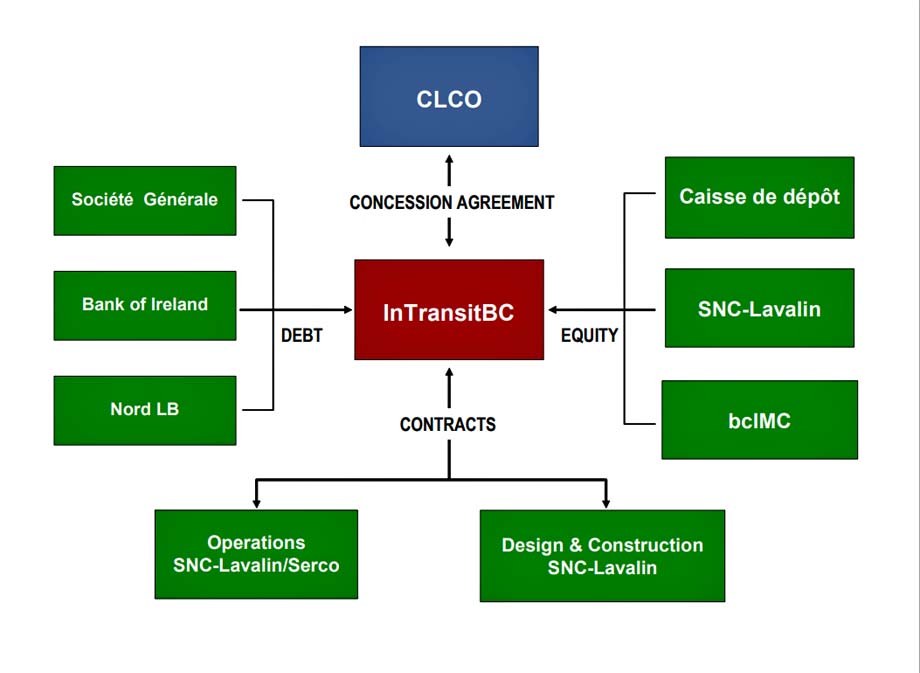Canada Line Construction William Slim |

Vancouver British Columbia - A final deal to build the Richmond-Airport-Vancouver rapid transit line was unveiled Tuesday with a price tag of $1.9 billion, up $180 million from the previous estimate of $1.72 billion.
Construction will begin as early as mid-September.
Taxpayers are not on the hook for the increase. It will be covered by the winning bidder for the RAV Line (Canada Line), SNC-Lavalin, and two new partners who stepped forward Tuesday, the B.C. Investment Management Corp. and the Caisse de depot et placement du Quebec, which operate huge public-sector pension-plan investment pools in their respective provinces.
The three companies are equal partners in InTransitBC, which will build and operate the RAV Line.
"We've now finalized our contract with InTransitBC, and that allows us to commence construction," said Jane Bird, chief executive of Ravco, the TransLink subsidiary overseeing the project.
"After much planning and discussion, we're really in a position to break ground."
Bird said the public-sector contribution to the RAV Line is virtually unchanged at $1.25 billion.
"We have a fixed price contract with InTransitBC with a firm delivery date of November 2009," she said.
The last details of the deal were settled Friday and the contract signed early Saturday.
The final tally of capital investment in the line shows the federal government is contributing about $419 million, the B.C. government $235 million, TransLink $245 million, the Vancouver International Airport Authority $321 million, and the City of Vancouver, which is paying for an extra station it wants built, $27 million, for total public investment of $1.247 billion.
InTransitBC is investing $657 million, for a total of $1.9 billion.
Asked if InTransitBC can make a profit over the term of its 35 year contract to build and operate the line, public affairs vice-president Steve Crombie said, "Yes, absolutely."
Crombie said InTransitBC was able to attract additional investment because the RAV Line is considered to be "a very solid project."
"We've also been able to identify some cost savings and operating revenue from the line that have made it easier to attract private-sector financing."
InTransitBC has already handed a construction contract to SNC-Lavalin worth about $1.5 billion.
Taxpayers are insulated from construction cost overruns, which are InTransitBC's responsibility. SNC-Lavalin, which is building projects all over the world from the new Bennett Bridge at Kelowna to a liquid natural gas converter in Algeria and a sulphuric acid plant in Russia, is experienced at keeping costs down, said senior vice-president Jim Burke.
TransLink, and Greater Vancouver taxpayers, do face some risk after the line opens if ridership falls short of projections.
Because it's in charge of setting ticket prices, promoting the line, and providing feeder bus lines, ridership shortfalls are TransLink's responsibility.
Don Toffaletto, a long-time opponent of the RAV Line, said he thinks that will be a problem.
"The people who are eventually going to pay for this are Greater Vancouver taxpayers," said Toffaletto, co-chair of the Re-Think RAV Coalition.
Toffaletto said neither the Expo Line nor the Millennium Line has achieved ridership projections and he expects the RAV Line to fall short as well.
The project faces one more legal challenge from another group, the Do Rav Right Coalition, a group of merchants and residents along Cambie Street who object to the amount of cut-and-cover construction, fearing it will disrupt their businesses and their lives. The group has filed a court appeal seeking to have the project stopped or changed, but Bird indicated Ravco isn't worried and construction will start immediately.
Toffaletto wasn't convinced.
"I'm not so sure that it's unstoppable," he said.
"It may still fall apart."
Ravco said it will publish a "final project report" before the end of the year reviewing the bidding process for the RAV Line. In Victoria, Auditor-General Wayne Strelioff said he had accepted Ravco's invitation to examine the report.
Early construction activity will include building a precast concrete facility at Kent and Fraser in south Vancouver that will make some of the tunnel, bridge, and guideway segments for the line.
In mid to late September, some streets will be dug up in Vancouver and Richmond to relocate electric, water, and sewer lines along the route.
Work on bridges spanning the north and middle arms of the Fraser River will likely begin in October.
The east-side lanes of Cambie Street near Queen Elizabeth Park will likely be closed late in the fall and two-way traffic will be routed along the west-side lanes. However, cut-and-cover construction won't begin until late 2006.
RAV Changes
The final version of the RAV line is still recognizable as the project approved last year by TransLink. But some of the details have changed. It's a 20-kilometre SkyTrain-like rapid transit line connecting downtown Vancouver with the airport and Richmond. That hasn't changed. These things have:
Author unknown.